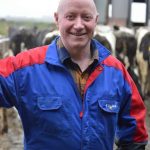
Monitoring dairy calves with precision technologies based on the “internet of things,” or IoT, leads to the earlier diagnosis of calf-killing bovine respiratory disease, according to a new study. The novel approach -; a result of crosscutting collaboration by a team of researchers from Penn State, University of Kentucky and University of Vermont -;will offer dairy producers an opportunity to improve the economies of their farms, according to researchers.
This is not your grandfather’s dairy farming strategy, notes lead researcher Melissa Cantor, assistant professor of precision dairy science in Penn State’s College of Agricultural Sciences. Cantor noted that new technology is becoming increasingly affordable, offering farmers opportunities to detect animal health problems soon enough to intervene, saving the calves and the investment they represent.
IoT refers to embedded devices equipped with sensors, processing and communication abilities, software, and other technologies to connect and exchange data with other devices over the Internet. In this study, Cantor explained, IoT technologies such as wearable sensors and automatic feeders were used to closely watch and analyze the condition of calves.
Such IoT devices generate a huge amount of data by closely monitoring the cows’ behavior. To make such data easier to interpret, and provide clues to calf health problems, the researchers adopted machine learning -; a branch of artificial intelligence that learns the hidden patterns in the data to discriminate between sick and healthy calves, given the input from the IoT devices.
“We put leg bands on the calves, which record activity behavior data in dairy cattle, such as the number of steps and lying time,” Cantor said. “And we used automatic feeders, which dispense milk and grain and record feeding behaviors, such as the number of visits and liters of consumed milk. Information from those sources signaled when a calf’s condition was on the verge of deteriorating.”
Bovine respiratory disease is an infection of the respiratory tract that is the leading reason for antimicrobial use in dairy calves and represents 22% of calf mortalities. The costs and effects of the ailment can severely damage a farm’s economy, since raising dairy calves is one of the largest economic investments.
“Diagnosing bovine respiratory disease requires intensive and specialized labor that is hard to find,” Cantor said. “So, precision technologies based on IoT devices such as automatic feeders, scales and accelerometers can help detect behavioral changes before outward clinical signs of the disease are manifested.”
In the study, data was collected from 159 dairy calves using precision livestock technologies and by researchers who performed daily physical health exams on the calves at the University of Kentucky. Researchers recorded both automatic data-collection results and manual data-collection results and compared the two.
In findings recently published in IEEE Access, a peer-reviewed open-access scientific journal published by the Institute of Electrical and Electronics Engineers, the researchers reported that the proposed approach is able to identify calves that developed bovine respiratory disease sooner. Numerically, the system achieved an accuracy of 88% for labeling sick and healthy calves. Seventy percent of sick calves were predicted four days prior to diagnosis, and 80% of calves that developed a chronic case of the disease were detected within the first five days of sickness.
“We were really surprised to find out that the relationship with the behavioral changes in those animals was very different than animals that got better with one treatment,” she said. “And nobody had ever looked at that before. We came up with the concept that if these animals actually behave differently, then there’s probably a chance that IoT technologies empowered with machine learning inference techniques could actually identify them sooner, before anybody can with the naked eye. That offers producers options.”
Contributing to the research were: Enrico Casella, Department of Animal and Dairy Science, University of Wisconsin-Madison; Melissa Cantor, Department of Animal Science, Penn State University; Megan Woodrum Setser, Department of Animal and Food Sciences, University of Kentucky; Simone Silvestri, Department of Computer Science, University of Kentucky; and Joao Costa, Department of Animal and Veterinary Sciences, University of Vermont.
This work was supported by the U.S. Department of Agriculture and the National Science Foundation.

























